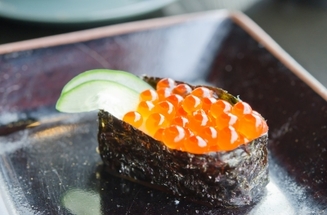Marrow, Aero and Jell-O
 Image credit: freedigitalphotos.net/rakratchada torsap
Image credit: freedigitalphotos.net/rakratchada torsap
Appeared as the column "Good Food" in Taconic Weekend, an arts supplement published by Taconic Press (RIP).
Gimme my gristle.
I love sinewy, gristly meats. Many people prefer a nice boneless chicken breast or steak, but I like to wrestle my meat off the bone with my teeth, with bits of gristle grabbing it, so that I have to work for each morsel. Meats that give me that kind of satisfaction are oxtail, short ribs and veal shanks (osso buco). When simmered for hours in a savory sauce, the bone and sinews flavor the whole and give it an intensely rich flavor. The grizzliness is part of the charm.
But when I was a child, I wouldn't go near bone marrow. I watched with revulsion that bordered on horror as my father dug it out of his marrowbones with the tip of his knife and ate it. We'd all give him ours, because the stuff just looked too nasty to even taste. It wasn't until fairly recently that I decided to give it a try, and I soon rued all those given-away bones. It's intense, a gelatinous buttery stuff with the flavor of meat and that scrumptious gristly taste all mixed together.
Other fats are delightful textures in and of themselves, and give food that "mouthfeel" that you don't get from nonfat. The holy triumvirate of onion, carrot and celery that goes into a soffritto or mirepoix is unified by the fat that marries it all together as a flavor base for the dish to follow. In India, they use fat to host spices.
Other foods that are silky smooth on the tongue are pudding and ice cream, which are usually more about texture than flavor. Melted ice cream just isn't the same. Why is pudding so comforting? Is it because our mothers made it or because it's so thick and smooth? I find soupy rice dishes to be immensely comforting as well, from chicken soup with rice to the Latin asopao to the Asian congee.
Tapioca has a texture that some of us love, gooey and thick with tiny fish eyeballs that roll over the tongue. Not for everyone, but delightful to those of us that glory in food textures full of unapologetic character.
Similar is salmon roe, those jewel-like perfect orbs that shine and glimmer and tease the tongue with salt and fish-essence, and then yield as they are crushed by the pressure of the tongue in an explosion of sea-tastes. The slight crunch of the much tinier flying-fish roe is not nearly as impressive.
Sea urchin, another sushi topping, is ochre rather than deep coral in color, and all smooth and creamy, rich and decadent. My favorite is yellowtail, that feels like the crisp thick satin silk of my wedding dress. Its slightly resistant silkiness on the tooth and tongue is intensely rich in the way that not-quite-ripe avocado is, but mild and unassuming in flavor.
Part of the appeal of Asian food is that it is designed with balance and texture in mind. Not only do many Asian dishes have complementary sweet/sour things going on, but have pleasing textural contrasts, too. An example is the heavenly Thai dish Pad Thai, in which the sweet crunch of bean sprouts, the salty crunch of peanuts and the mild crispiness of fried tofu dance on a bed of soft noodles.
Crispiness is the reason I adore flavorless water chestnuts, too.
Flakiness is another delightful texture that teases the tongue. Good pie pastry has this quality, as do croissants and one of my favorite chocolate bars, Cadbury's Flake.
Another nice texture thing is the airy Aero, a chocolate bar with bubbles in it. I used to spend my bus money on it when I lived in Ireland at age ten, and was thrilled to find it recently at Wild Geese Imports in Rhinebeck.
And I love velvety melted chocolate on almost anything. Well, maybe not oxtail.
Although we used to call green Jell-O, "frog guts," I've never lost my taste for the stuff. The flavor is pure fakeness and citric acid, but I like the way it talks back to you and seems alive in your mouth. I don't care if it's made of horse toenails.
Not all textures are so agreeable; mealy and slimy could make even ambrosia unpleasant. I wasn't the typical picky eater kid, and there were only three things I didn't like, all for reasons of texture rather than taste. Okra has a nice mild green taste, not offensive in any way, but when simply boiled it has a slimy gooeyness that I didn't think food should have. I've since had okra fried crispy or bathed in scrumptious gumbo and now love it. But that slime put me off for a long time.
Liver was another thing I couldn't abide. It's mealiness gagged me. Although the taste was no stronger than the kidneys we ate from time to time, I thought liver was the most inedible thing on the planet. To this day I like it in a pâté with its texture completely disguised, or not at all.
I thought anchovies were too salty, too oily, filled with tiny prickly bones, and had no place on a plate. But now I've come to love them, too, draped over a salad or pizza or melted into a luscious tomato sauce for pasta. I've made peace with the foods I didn't like, and in new forms, born in new textures, I love them.
From the crunch of potato chips (they just wouldn't be as fun if they were limp) to the crisp of roasted duck skin to the interminable chewiness of Cape Cod salt water taffy, food with texture is food that's more fun.
Gimme my gristle.
I love sinewy, gristly meats. Many people prefer a nice boneless chicken breast or steak, but I like to wrestle my meat off the bone with my teeth, with bits of gristle grabbing it, so that I have to work for each morsel. Meats that give me that kind of satisfaction are oxtail, short ribs and veal shanks (osso buco). When simmered for hours in a savory sauce, the bone and sinews flavor the whole and give it an intensely rich flavor. The grizzliness is part of the charm.
But when I was a child, I wouldn't go near bone marrow. I watched with revulsion that bordered on horror as my father dug it out of his marrowbones with the tip of his knife and ate it. We'd all give him ours, because the stuff just looked too nasty to even taste. It wasn't until fairly recently that I decided to give it a try, and I soon rued all those given-away bones. It's intense, a gelatinous buttery stuff with the flavor of meat and that scrumptious gristly taste all mixed together.
Other fats are delightful textures in and of themselves, and give food that "mouthfeel" that you don't get from nonfat. The holy triumvirate of onion, carrot and celery that goes into a soffritto or mirepoix is unified by the fat that marries it all together as a flavor base for the dish to follow. In India, they use fat to host spices.
Other foods that are silky smooth on the tongue are pudding and ice cream, which are usually more about texture than flavor. Melted ice cream just isn't the same. Why is pudding so comforting? Is it because our mothers made it or because it's so thick and smooth? I find soupy rice dishes to be immensely comforting as well, from chicken soup with rice to the Latin asopao to the Asian congee.
Tapioca has a texture that some of us love, gooey and thick with tiny fish eyeballs that roll over the tongue. Not for everyone, but delightful to those of us that glory in food textures full of unapologetic character.
Similar is salmon roe, those jewel-like perfect orbs that shine and glimmer and tease the tongue with salt and fish-essence, and then yield as they are crushed by the pressure of the tongue in an explosion of sea-tastes. The slight crunch of the much tinier flying-fish roe is not nearly as impressive.
Sea urchin, another sushi topping, is ochre rather than deep coral in color, and all smooth and creamy, rich and decadent. My favorite is yellowtail, that feels like the crisp thick satin silk of my wedding dress. Its slightly resistant silkiness on the tooth and tongue is intensely rich in the way that not-quite-ripe avocado is, but mild and unassuming in flavor.
Part of the appeal of Asian food is that it is designed with balance and texture in mind. Not only do many Asian dishes have complementary sweet/sour things going on, but have pleasing textural contrasts, too. An example is the heavenly Thai dish Pad Thai, in which the sweet crunch of bean sprouts, the salty crunch of peanuts and the mild crispiness of fried tofu dance on a bed of soft noodles.
Crispiness is the reason I adore flavorless water chestnuts, too.
Flakiness is another delightful texture that teases the tongue. Good pie pastry has this quality, as do croissants and one of my favorite chocolate bars, Cadbury's Flake.
Another nice texture thing is the airy Aero, a chocolate bar with bubbles in it. I used to spend my bus money on it when I lived in Ireland at age ten, and was thrilled to find it recently at Wild Geese Imports in Rhinebeck.
And I love velvety melted chocolate on almost anything. Well, maybe not oxtail.
Although we used to call green Jell-O, "frog guts," I've never lost my taste for the stuff. The flavor is pure fakeness and citric acid, but I like the way it talks back to you and seems alive in your mouth. I don't care if it's made of horse toenails.
Not all textures are so agreeable; mealy and slimy could make even ambrosia unpleasant. I wasn't the typical picky eater kid, and there were only three things I didn't like, all for reasons of texture rather than taste. Okra has a nice mild green taste, not offensive in any way, but when simply boiled it has a slimy gooeyness that I didn't think food should have. I've since had okra fried crispy or bathed in scrumptious gumbo and now love it. But that slime put me off for a long time.
Liver was another thing I couldn't abide. It's mealiness gagged me. Although the taste was no stronger than the kidneys we ate from time to time, I thought liver was the most inedible thing on the planet. To this day I like it in a pâté with its texture completely disguised, or not at all.
I thought anchovies were too salty, too oily, filled with tiny prickly bones, and had no place on a plate. But now I've come to love them, too, draped over a salad or pizza or melted into a luscious tomato sauce for pasta. I've made peace with the foods I didn't like, and in new forms, born in new textures, I love them.
From the crunch of potato chips (they just wouldn't be as fun if they were limp) to the crisp of roasted duck skin to the interminable chewiness of Cape Cod salt water taffy, food with texture is food that's more fun.

